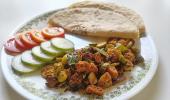
Before our trains got upgraded to sleek, superfast Vande Bharats and Durontos, there were the nostalgic joys of those leisurely rail journeys across India of our childhood. Wistful memories of riding the rails late into the night in the comfort of your upper berth, lulled to sleep by the musical clickety-clack of metal wheels on tracks.
Being India, those trips were closely intertwined with food, of course. There were all those as-much-as-you-could-carry-and-not-collapse tiffins, brimming with parathas, theplas, puris, sabzis, tamarind rices, biryanis, idlis, laddus, chuda etc etc, made at home, that accompanied a family on a train voyage, as if they were going into exile.
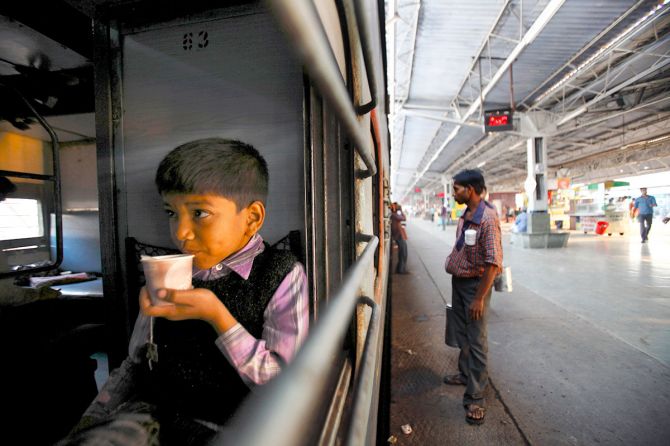
Then each station or train ride was associated with distinctive food or dining experiences.
In the days when trains still had fancy dining cars, I remember breakfasts of chai, omelets and smoky toast, as you looked out, through enormous open windows, in awe, at the overpoweringly beautiful jungle or mountain scenery. And the divided steel trays, heaped with food, that my grandparents ordered for dinner to their berths. Or the dubious-looking tomato soup that came floating down the aisles that made you realise it should be India’s national dish, so popular was it with travellers.
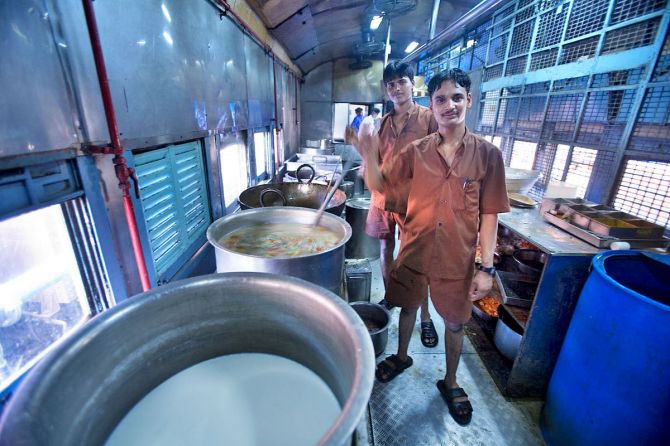
Several stations once had elegant dining rooms or 'refreshment' rooms -- Madras Central, Bombay Victoria Terminus, Howrah, Old Delhi, Lucknow, Mughal Sarai and so many others. Grandly-built Nagpur station, for instance, had an airy, old-style, high-ceilinged dining room on the first floor, where waiters in light blue livery scurried efficiently between the marble tables serving up a variety of meals including, surprisingly, wonderful idlis.
Every station -- India has over 7,000 -- was connected to a unique kind of wonderful-tasting food. So, you were also working your way across a food map, where delicacies changed every few kilometres.
One waited, hungrily, while on this Great Indian Culinary Journey, in special anticipation for the arrival of each station and for the selection of delicious food it could promisingly offer.
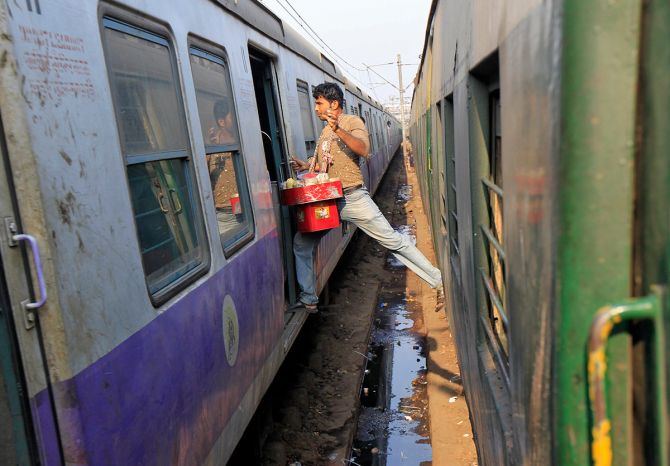
When you chugged into Guntakal you had to eat its signature pongal. Vijaywada was known for the softest idlis, crispy dal wadas and lemon rice served on a banana leaf.
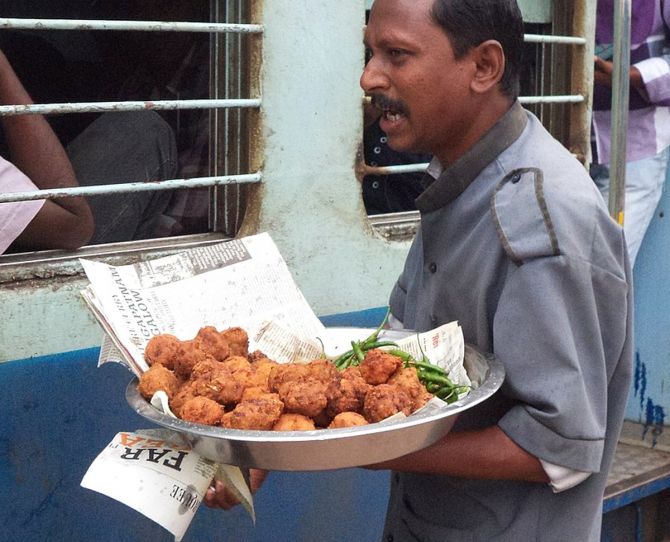
Photograph: Kind courtesy Raj.palgun13/Wikimedia Commons
Barwaha had a name because of its famous chivda.
Chakradharpur was about its long, light green, coiled kakdis spiced up with chilly and lemon.
Sweet-smelling halwa was to be had at Tirunelveli.
Igatpuri, before you descended the ghats, for tongue-tickling Vada Pav.
Sandila in Hardoi was legendary, near and far, for sugary, powdery crushed boondi laddoos.
Dal ki pakodis at Sawaimadhopur.
Gorgeous Chhole Bhatura from Jalandhar City Junction.
The plumpest guavas in season could be found at Allahabad.
Freshly-tossed jhaalmuri at all the Jharkhand rail halts.
Yummy mutton biryani at Dindigul.
Chicken cutlets at Howrah.
Fresh, long papaya slices, served up on bright green leaves at Jharsuguda.
Maddur vade at Maddur.
Alu Tikkis at Tundla.
Dana Methi Ki Sabzi and Puri at Ringus.
Jamrukh at Dahanu.
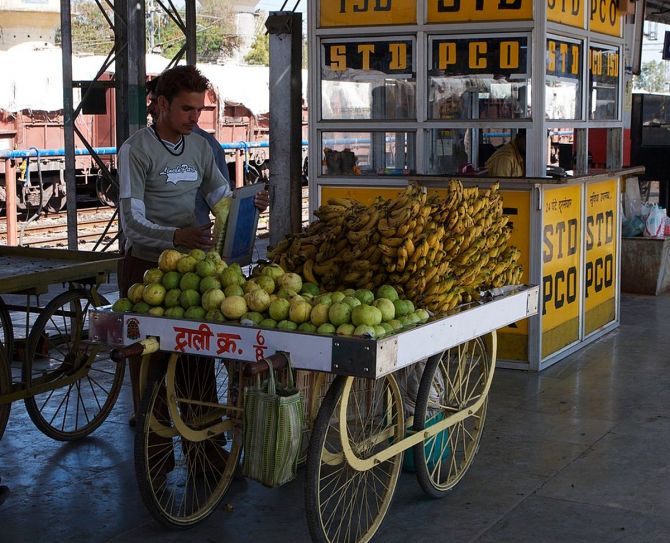
Litti Chokha sold at various Bihari railway stops.
Rasgullas at Luni Junction.
The best oranges were at Nagpur.
Bananas from Bhusaval.
Lonavla for its chikki.
Surat for nankhatai and ghari.
Ripe banana fritters or Pazham Pori at Shoranur station.
Bareilly Junction was mashoor for its mung dal pakodas.
Roasted unshelled peanuts, ubiquitous railway cutlets and steaming kulhad chai were additional standard fare in umpteen stations across India.
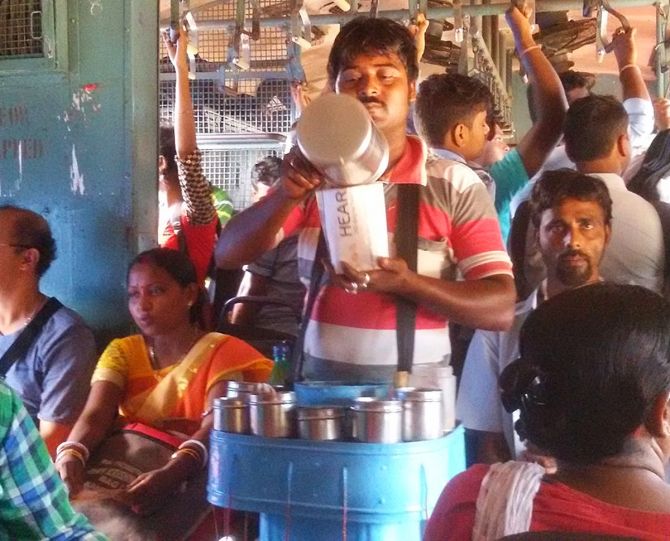
For me, Allahabad station meant tucking into puris and raseela alu. The puri cart was always parked right next to the train, on the platform, and as the Howrah Mail was pulling into the station, from far away you could see fragrant puris, like little hot air balloons literally levitating themselves out of the kadhais of hot oil to be eaten with a spicy alu curry.
Recreating that earthy but very simple Railway Puri and Raseela Alu at home is not hard at all. And tastes far better than what you might eat at your nearby puri joint or order packed to your home, because reaching piping hot puris to the dining table, to be had with alu curry, is a special experience.
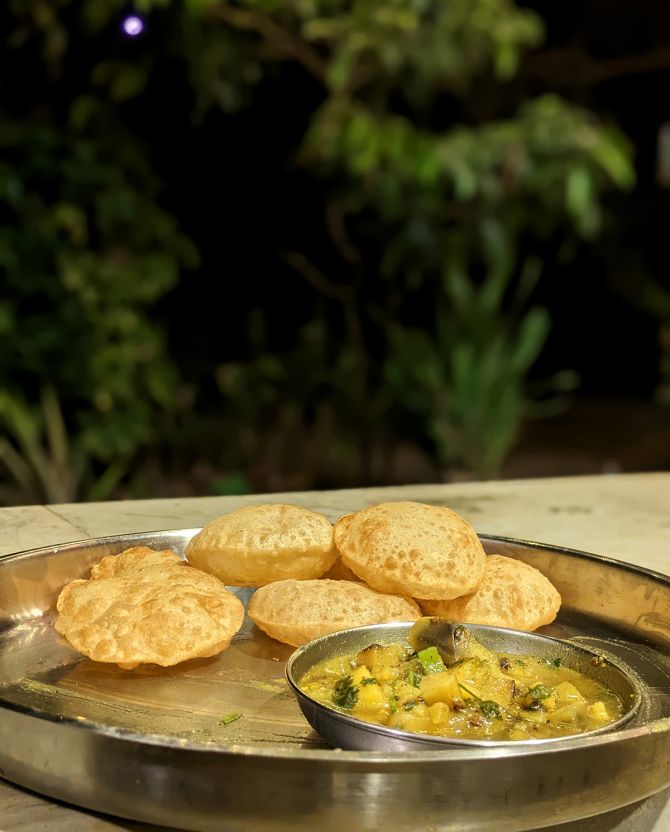
Railway Puri and Raseela Alu Curry
Serves: 4-5
For the raseela alu
- 4 very large potatoes, peeled and chopped into 1-inch pieces
- 2 tbsp oil
- 1 tsp jeera or cumin seeds
- ½ tsp hing or asafetida
- 1 tsp haldi or turmeric powder
- Dash lal mirchi or red chilly powder
- 4-5 dark green chillies, chopped fine
- Dash sugar
- 2 tbsp dhania powder
- Salt to taste, about 1 tsp
- 2 cups water
- Handful chopped green dhania or coriander or cilantro
For the puris
- 2 cups aata or wheat flour + little extra for sprinkling while rolling
- 2 handfuls suji or semolina
- ½ tsp salt
- Water
- Dash oil
- Oil for deep frying
Method
For the raseela alu
- Heat the oil in a kadhai or large saucepan over medium-high heat.
Add the jeera and the hing.
Fry for a minute.
Add the haldi and then the alu.
Fry for about 10-15 minutes, stirring often.
Add the water, green chillies, salt, sugar, dhania powder and bring the water to a boil.
Allow the curry to simmer over medium heat for about 15 minutes till the alu is cooked. - Take off heat and garnish with green dhania.
For the puris
- In a large bowl, or parat or aata saane-wallah thali, make a stiff-ish dough with the aata, suji, oil, salt and not too much water.
Cover and allow it to rest 15 minutes. - The traditional way to make puris is to roll each puri out individually but to make many puris fast and serve hot I prefer rolling out a large quantity of dough and cutting small circles out with a katori or cutter.
- Heat the oil for deep frying over medium-high heat.
- Divide the dough into three portions.
Roll out one portion on a floured ledge or large flat surface, not too thin -- puris are always rolled a little thicker than rotis.
Using a steel katori or bowl, cut out 3-inch diameter circles.
Fry this first lot.
Pop a circle into the oil.
Fry on one side, swilling oil over the circle of dough, and lightly pressing down with the spatula, so it starts to puff up.
Flip over fry the puri till lightly red.
Drain from oil onto a tissue or paper towel-lined plate and repeat for the rest of the circles. - The roll out the second portion of dough and repeat the cuttin and frying process and then too for the final portion of dough.
- Serve the puris hot with the raseela alu, pickle and yoghurt -- onion pickle, jackfruit pickle, eggplant or brinjal pickle, mango pickle and lemon pickle are good matches.



